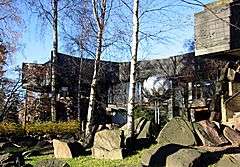Dipoli
| Dipoli | |
|---|---|
 | |
| General information | |
| Type | Conference Center |
| Architectural style | Expressionist Modern[1] |
| Location |
|
| Coordinates | 60°11′6″N 24°49′57″E / 60.18500°N 24.83250°ECoordinates: 60°11′6″N 24°49′57″E / 60.18500°N 24.83250°E |
| Construction started | 1965 |
| Completed | 1966 |
| Design and construction | |
| Architect | Reima and Raili Pietilä |
Dipoli is a conference center located in Espoo, Finland as a part of the Otaniemi campus of the Aalto University (successor of Helsinki University of Technology, TKK). It was designed by architects Reima and Raili Pietilä and completed in 1966.
Name
The name of the building is a pun: it can mean dipole in Finnish, but also "the second Poly", the second building of the polytechnic students.[2][3] The original Polytechnic Students' Union, now called the "Old Poly" (Finnish: Vanha Poli), was a National Romantic building located on Lönnrotinkatu in Helsinki that was left behind when the university moved to Otaniemi.
History
When Helsinki University of Technology moved from Helsinki to Espoo in the early 1960s, an architecture competition was held for what would become the new building for the Student Union of the university. Due to the challenging rocky location and adaptability requirements none of the competition entries fulfilled all the jury's demands and the first prize was not given. The second prize was shared by the architect couple Reima and Raili Pietilä and Osmo Lappo who were asked to further develop their proposals. In the end the 1961 design by Pietiläs was used as the basis for the design of the Dipoli building. Work began in 1965, and the building was ready for use in autumn 1966.[4][3][5]
In 1993 the building was transformed into a training centre of the university due to high maintenance costs. Besides its primary role, Dipoli is still regularly used for conventions, congresses and student parties. The building houses over 20 conference rooms and auditoriums.[3]
Dipoli was owned by the student union of Aalto University until 2013 when it was announced that the building would be sold to the university itself for an undisclosed sum.[5] The building is currently under extensive renovations which will turn it into Aalto University's main building by late 2016.[6]
Architecture
The building uses extensively materials from Finnish nature, such as pine wood, copper, and natural rocks. Dipoli has 500 windows of which only four are identical.[3] The architects originally planned for as little interference with the natural granite of the site as possible; but blasting the hard granite base rock inevitably fragmented it. The building is seen as a key example of organic architecture. Reima Pietilä himself said of the building:
"As in Samuel Beckett's novels, there are no exposed trenchmarks of balance. The concept of a traditional balance of composition is redundant in the design aesthetics of Dipoli. (...) after the hill top was blasted the broken heaps of rocj gave an initial image which one could follow with the slow, crawling motion of structure. The reptilian metaphoric image: the silhouetted dinosaur accentuating the rhythmic consistency of retardation."[7]
References
- ↑ "Dipoli Conference Center". GreatBuildings. Retrieved February 18, 2014.
- ↑ Maarit Kaimio. "Eurolatinaa Meritalandiassa" (in Finnish). Institute for the Languages of Finland. Retrieved February 18, 2014.
- 1 2 3 4 "History of Dipoli". Aalto University. October 31, 2012. Retrieved February 18, 2014.
- ↑ Johansson, Eriika; Paatero, Kristiina; Tuomi, Timo, eds. (2008). Raili ja Reima Pietilä: Modernin arkkitehtuurin haastajat (in Finnish). Museum of Finnish architecture. ISBN 978-952-5195-29-3.
- 1 2 Johanna Sjöholm (December 20, 2013). "Opiskelijat luopuvat Otaniemen Dipolista" (in Finnish). Helsingin Sanomat. Retrieved February 14, 2014.
- ↑ "Dipoli to be renovated and turned into unique main building of Aalto". Aalto University. 9 June 2015. Retrieved 24 September 2015.
- ↑ Malcolm Quantrill, Finnish Architecture and the Modernist Tradition, E & FN Spons, London, 1995, p.164